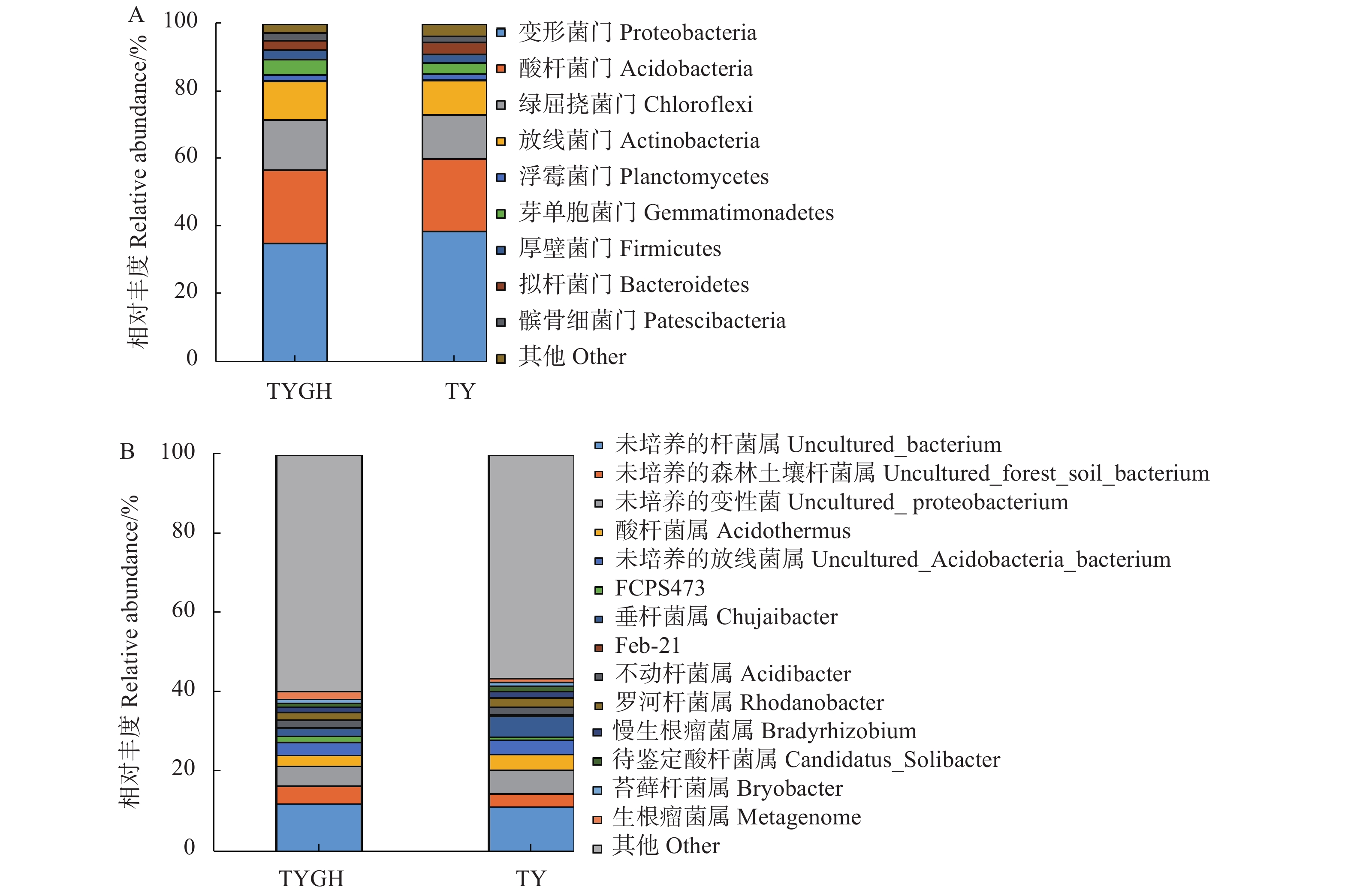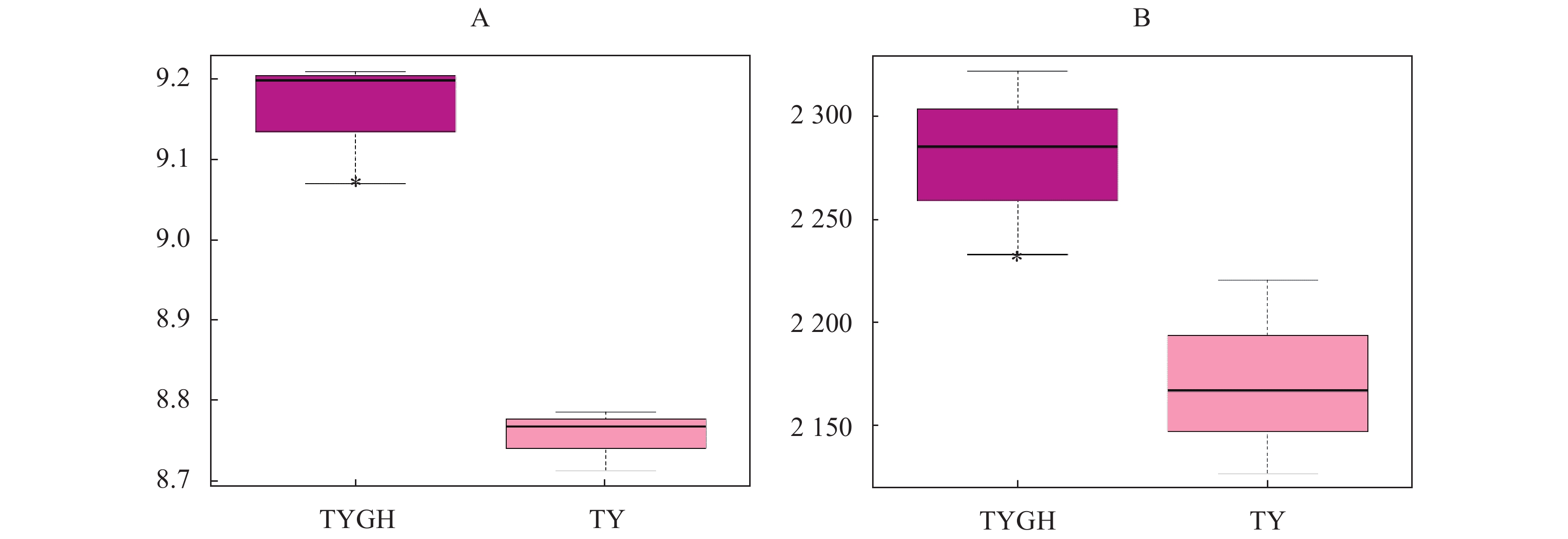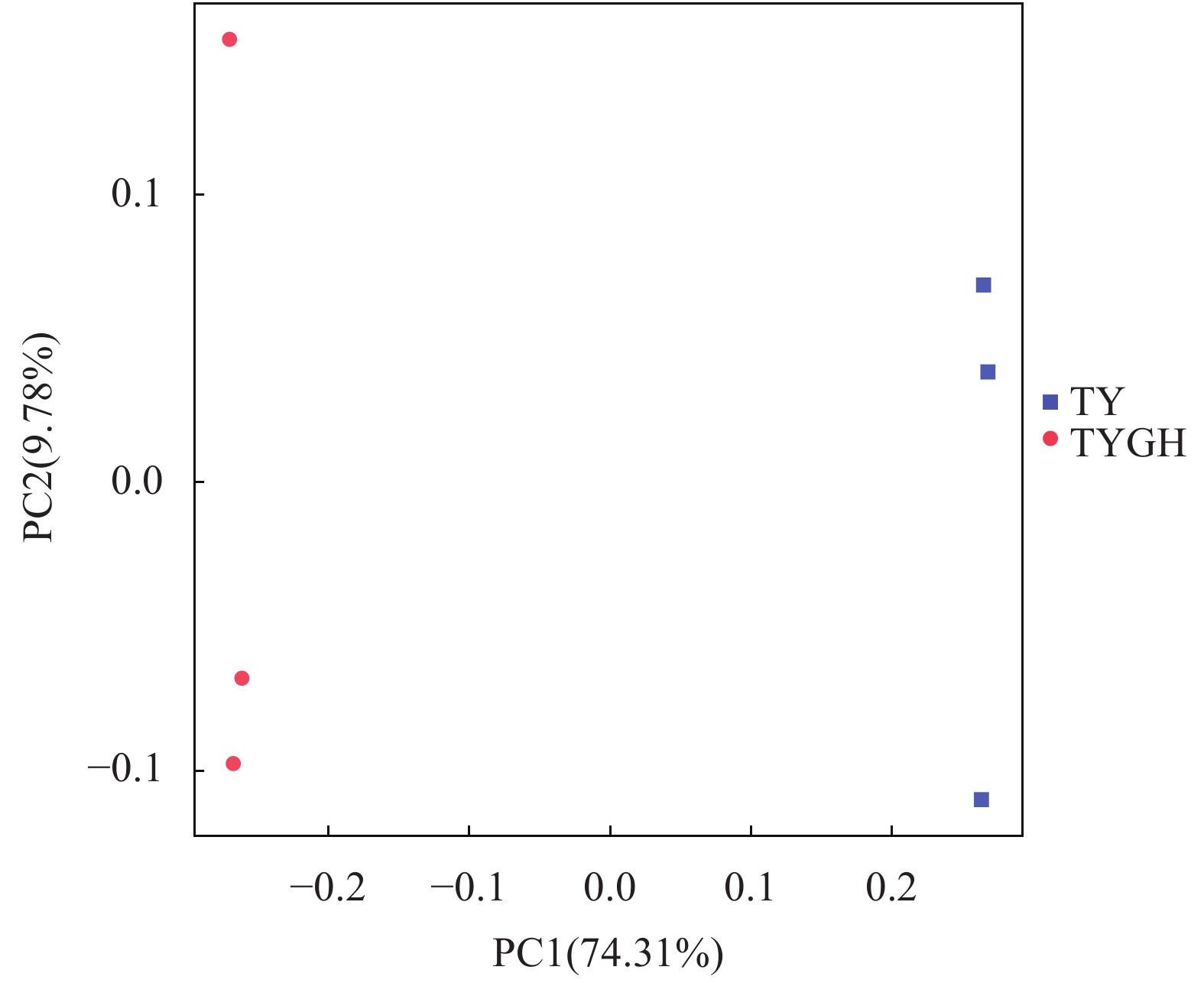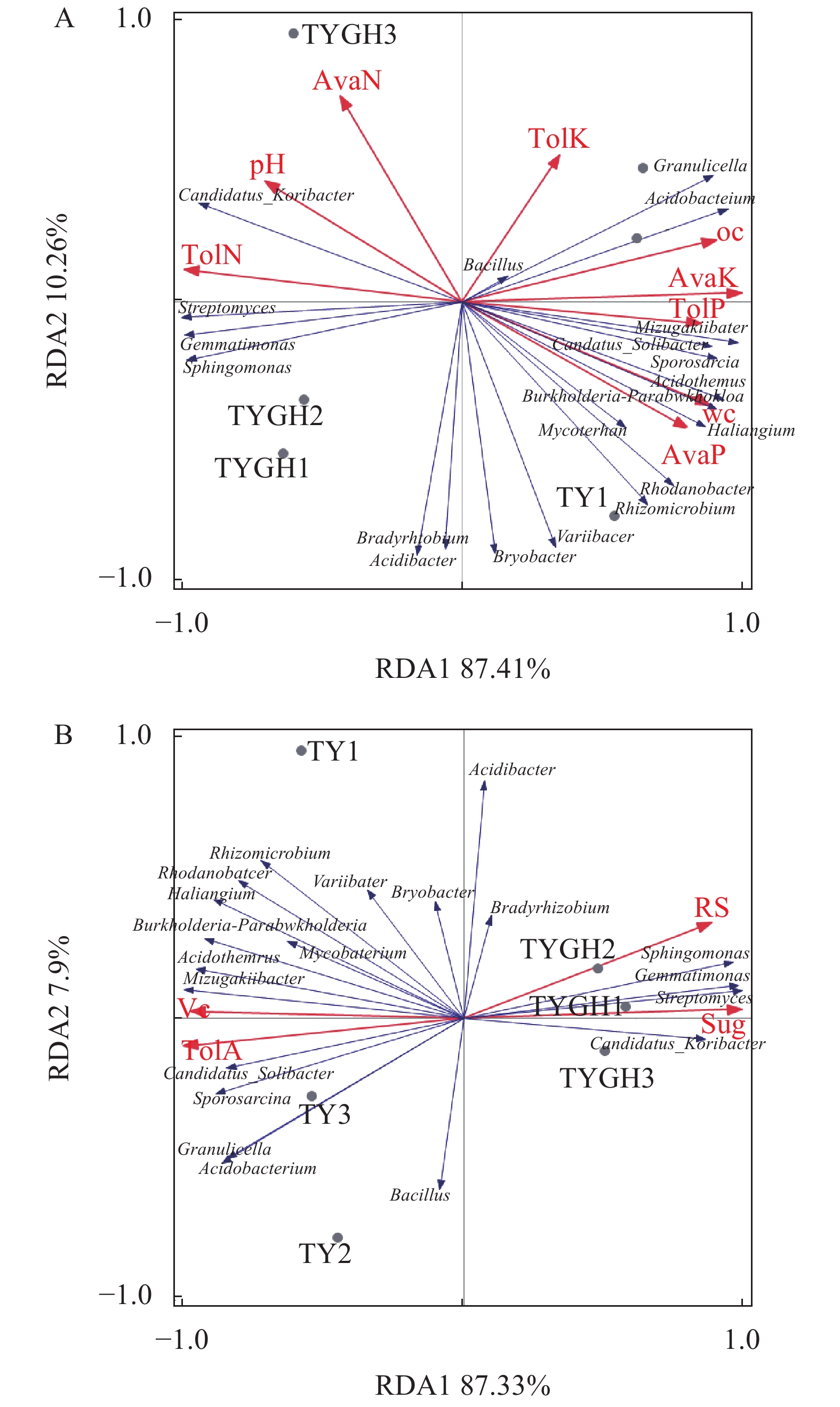Effects of Rain-shelter cultivation on the rhizosphere bacterial communities of pear trees
-
摘要:
目的 研究避雨栽培对梨树根际土壤细菌群落的影响,为完善避雨栽培土壤管理措施提供理论依据。 方法 以同一梨园进行避雨和露地处理的梨树根际土壤为研究对象,测定和分析不同栽培方式对梨树根际微生物群落的影响以及其与土壤化学性质和梨果实品质之间的关系。 结果 梨树果实品质测定结果表明,相对于露地栽培,避雨栽培可以显著提高梨果实的蔗糖、还原糖含量,分别提高了1.83倍和1.08倍,但维生素C和总酸含量显著降低,分别减少了1.23倍和1.20倍。糖酸比显著增加,果实品质更好。梨园土壤化学性质结果表明,避雨处理的土壤速效磷、速效钾、有机质含量及含水量显著低于露地处理,全氮显著高于露地处理。根际土壤微生物测序分析结果表明,避雨处理的梨树根际土壤在门水平的细菌群落主要以变形菌门(Proteobacteria)、酸杆菌门(Acidobacteria)、绿弯菌门(Chloroflexi)和放线菌门(Actinobacteria)为主,露地处理的梨树根际土壤在门水平的细菌群落主要以不可培养细菌(uncultured bacterium)、不可培养的森林土壤细菌(uncultured forest soil bacterium)和不可培养的变形菌(uncultured proteobacterium)为主;避雨处理显著增加根际微生物多样性和丰富度。相关性分析结果表明,避雨栽培根际微生物属多样性与全氮、速效氮含量和pH值正相关,但与全钾、全磷、速效钾、速效磷、有机质和水分含量呈负相关,而与果实蔗糖和还原糖含量正相关。 结论 避雨栽培对微生物多样性和丰富度有促进作用,增强梨树根际微生态环境的稳定性,有利于梨树生长和果实产量和品质,但不利于土壤的物质循环。适当的露地栽培有利于梨园的土壤物质循环,提高梨园生产的可持续性。 Abstract:Objective To provide a theoretical basis for improving soil management measures of rain shelter treatment, the effects of rain shelter treatment on the bacterial community of pear tree rhizosphere soil were studied. Method The fruit qualities, and soil chemical properties and taxonomic composition of bacteria communities were determined under rain-shelter treatment and open field treatment in the same pear orchard. The correlation between bacterial communities in the rhizosphere of pear trees and the physio-chemical and fruit quality indicators under different treatments were analyzed. Result The results of pear fruit quality showed that the content of sucrose and reducing sugar under rain-shelter treatment were increased by 1.83 times and 1.08 times, respectively, as much that under open field treatment. The content of vitamin C and total acid under rain-shelter treatment were significantly decreased by 1.23 times and 1.20 times, respectively, as much that under open field treatment. Compared with open field treatment, the ratio of sugar to acid in rain-sheltered treatment increased significantly and fruit quality was better. The results of soil chemical properties of pear orchard showed that the contents of available phosphorus, available potassium, organic matter and water content in the rain shelter treatment were significantly lower than those in the open field treatment, while the total nitrogen was significantly higher than that in the open field treatment. Sequencing analysis of rhizosphere soil microorganisms showed that the main bacterial communities in the rhizosphere soil of pear trees under rain shelter treatment were Proteobacteria, Acidobacteria, Chloroflexi and Actinobacteria at the phylum level. Uncultured bacterium, uncultured forest soil bacterium and uncultured proteobacterium were the main bacterial communities in the rhizosphere of pear trees in the open field. Rain-shelter treatment significantly increased rhizosphere microbial diversity and richness. Correlation analysis showed that the rhizosphere microbial diversity was positively correlated with total nitrogen, available nitrogen and pH value, but was negatively correlated with total potassium, total phosphorus, available potassium, available phosphorus, organic matter and water content, and was positively correlated with sucrose and reducing sugar content. Conclusion Rain-shelter cultivation can promote the diversity and richness of microorganisms, enhance the stability of the rhizosphere micro-ecological environment. Rain-shelter treatment is conducive to the growth of pear trees and the formation of fruit yield and quality, but it was disadvantageous to soil material circulation. Proper open shelter cultivation could make use of soil material circulation in pear orchard and improve the sustainability of pear orchard production. -
Key words:
- pear /
- rhizosphere soil /
- rain-sheltered treatment /
- rhizosphere microorganisms /
- quality indicators /
- soil chemistry
-
图 5 不同栽培模式下梨树根际土壤细菌群落的属级分类下与土壤理化性质(A)和梨品质(B)的相关性分析
注:TolN—土壤总氮,TolP—土壤总磷,TolK—土壤总钾,AvaN—速效氮,AvaP—速效磷,AvaK—速效钾,OC—有机质含量,WC—含水量,pH—pH值,Sug—蔗糖含量,还原糖含量,TolA—总酸,Vc—维生素C。
Figure 5. Correlation analysis between bacterial communities in the rhizosphere soil of pear trees at the genus level and the soil physio-chemical indexes(A)and fruit qualities under different cultivation modes
Note: TolN—Soil total nitrogen, TolP—Soil total phosphorus, TolK—Soil total potassium, AvaN—Rapid available nitrogen, AvaP—Rapid available phosphorus, AvaK—Rapid available potassium, OC—Organic content, WC—Water content, pH—Acidity or alkalinity gradients, Sug—Sucrose content, RS—Reducing sugar content, TolA—Total acid, Vc— Vitamin C.
表 1 不同栽培模式下梨果实品质
Table 1. The pear fruit qualities under different cultivation modes
样品
Samples蔗糖
Sucrose/g·hg−1还原糖
Reducing sugar/g·hg−1维生素C
Vitamin C/g·hg−1总酸
Total acid/g·kg−1糖酸比
Ratio of sugar to acidTYGH 1.28±0.01 a 7.17±0.01 a 6.18±0.05 b 1.20±0.01 b 70.42 TY 0.70±0.03 b 6.64±0.12 b 6.97±0.07 a 1.44±0.01 a 50.97 注:TYGH--避雨栽培, TY--露地栽培(图1~3同);小写字母表示P<0.05水平上的显著性(表2~3同)。
Note: “TYGH” represent rain-shelter cultivation, “TY” represent open field cultivation(The same as Fig.1-3). The lowercase represent significant difference at P<0.05 levels(The same as table 2-3.表 2 不同栽培模式下梨树根际土壤化学性质
Table 2. Chemical properties of soils from different treatment plots
指标 Index TYGH TY 全钾 Total potassium/(g·kg−1) 5.75±0.14 a 5.88±0.20 a 全氮 Total nitrogen/(g·kg−1) 7.73±0.37 a 4.20±0.15 b 全磷 Total phosphorus/(g·kg−1) 0.066±0.004 a 0.090±0.015 a 速效氮 Available nitrogen/(mg·kg−1) 21.47±2.13 a 18.96±1.47 a 速效磷 Available phosphorus/(mg·kg−1) 87.74±7.11 b 165.38±17.66 a 速效钾 Available potassium/(mg·kg−1) 165.65±2.60 b 229.74±5.54 a 有机质 Organic matter/% 7.64±1.68 b 16.16±0.38 a pH 5.05±0.03 a 4.92±0.11 a 含水量 Water content/% 14.33±0.88 b 20.33±1.76 a 表 3 梨树根际土壤微生物序列拼接结果和OUT数目统计
Table 3. Sequence alignment and OUT number statistics of pear rhizosphere soil microorganism
样品 Samples RT CT OTUs TYGH 40774±3196 b 40441±3164 b 2009±28 a TY 44728±2854 a 44328±2845 a 1830±20 b 注:RT(Raw_tags):经过过滤低质量的fastq数据拼接得到的结果,CT(Clean_tags):进一步对拼接结果去除嵌合体、短序列后得到的结果, OTUs为样本最终得到的平均OTU数目。
Note: RT is the result of merging the filtered low-quality fastq data, CT is the result of further removing chimera and short sequences from the merging result, and OTUs is the average number of OTUs of the samples. -
[1] AHN S Y, KIM S H, CHOI S J, et al. Characteristics of cold hardiness and growth of grapevines grown under rain shelter type cultivation system in the vineyard [J]. Korean Journal of Horticultural Science and Technology, 2012, 30(6): 626−634. doi: 10.7235/hort.2012.12102 [2] CAO M, GUO J N, GAO D T, et al. Research progress in effects of rain-shelter cultivation on quality of grape berry [J]. Agricultural Science & Technology, 2016, 17(5): 1120−1124. [3] 黄雪燕, 杨倩倩, 王涛, 等. 避雨栽培对大棚梨病虫害发生及果实品质的影响 [J]. 中国南方果树, 2012, 41(3):46−49.HUANG X Y, YANG Q Q, WANG T, et al. Effects of rain-shelter-cultivation on incidence of diseases and pests, and fruit qualities of pears [J]. South China Fruits, 2012, 41(3): 46−49.(in Chinese) [4] 常有宏, 刘永锋, 王宏, 等. 梨黑斑病病菌的致病条件 [J]. 江苏农业学报, 2008, 24(3):316−320. doi: 10.3969/j.issn.1000-4440.2008.03.020CHANG Y H, LIU Y F, WANG H, et al. Infection conditions of Alternaria Geisen to pear [J]. Jiangsu Journal of Agricultural Sciences, 2008, 24(3): 316−320.(in Chinese) doi: 10.3969/j.issn.1000-4440.2008.03.020 [5] 孙明星, 王晓荣, 张抗战. 梨树主要病虫害综合防治 [J]. 西北园艺(综合), 2018(4):43. doi: 10.3969/j.issn.1004-4183.2018.04.024SUN M X, WANG X R, ZHANG K Z. Integrated control techniques of main pear diseases and pests [J]. Northwest Horticulture, 2018(4): 43.(in Chinese) doi: 10.3969/j.issn.1004-4183.2018.04.024 [6] 陈剑. 梨树病虫害综合防治技术 [J]. 现代园艺, 2018(19):157−158. doi: 10.3969/j.issn.1006-4958.2018.19.084CHEN J. Integrated control techniques of pear diseases and pests [J]. Xiandai Horticulture, 2018(19): 157−158.(in Chinese) doi: 10.3969/j.issn.1006-4958.2018.19.084 [7] 何丽霞, 刘邮洲, 李慧, 等. 避雨栽培和露天栽培梨锈病和梨黑斑病发生差异 [J]. 江苏农业科学, 2019, 47(14):120−123.HE L X. Difference on occurrence of pear rust and pear black spot between rain-shelter cultivation and open-field cultivation [J]. Jiangsu Agricultural Sciences, 2019, 47(14): 120−123.(in Chinese) [8] 林志雄, 陆育生, 常晓晓, 等. 避雨栽培对广东寄接梨生长发育及果实品质的影响 [J]. 广东农业科学, 2016, 43(6): 64−68, 封2.LIN Z X, LU Y S, CHANG X X, et al. Effects of rain shelter cultivation on fruit development and quality of trans-grafting pear in Guangdong Province [J]. Guangdong Agricultural Sciences, 2016, 43(6): 64−68, cover 2.(in Chinese) [9] 陈小明, 曾少敏, 黄新忠. 避雨措施对梨品质、土壤化学性质与酶活性影响及相关性分析 [J]. 福建农业学报, 2018, 33(12):1270−1274.CHEN X M, ZENG S M, HUANG X Z. Effects of rain-sheltered pear cultivation on fruit quality and chemistry and enzymatic activity of rhizosphere soil [J]. Fujian Journal of Agricultural Sciences, 2018, 33(12): 1270−1274.(in Chinese) [10] HARDOIM P R, VAN OVERBEEK L S, ELSAS J D V. Properties of bacterial endophytes and their proposed role in plant growth [J]. Trends in Microbiology, 2008, 16(10): 463−471. doi: 10.1016/j.tim.2008.07.008 [11] WIELAND G, NEUMANN R, BACKHAUS H. Variation of microbial communities in soil, rhizosphere, and rhizoplane in response to crop species, soil type, and crop development [J]. Applied and Environmental Microbiology, 2001, 67(12): 5849−5854. doi: 10.1128/AEM.67.12.5849-5854.2001 [12] 国家食品药品监督管理总局, 国家卫生和计划生育委员会. 食品中果糖、葡萄糖、蔗糖、麦芽糖、乳糖的测定: GB/T 5009.8—2016[S]. 北京: 中国标准出版社, 2016. [13] 国家卫生和计划生育委员会. 食品中还原糖的测定: GB/T 5009.7—2016[S]. 北京: 中国标准出版社, 2016. [14] 国家卫生和计划生育委员会. 食品中抗坏血酸的测定: GB/T 5009.86—2016[S]. 北京: 中国标准出版社, 2016. [15] 中华人民共和国国家质量监督检验检疫总局, 中国国家标准化管理委员会. 食品中总酸的测定: GB/T 12456—2008[S]. 北京: 中国标准出版社, 2009. [16] 鲁如坤. 土壤农业化学分析方法[M]. 北京: 中国农业科技出版社, 2000. [17] MUNYAKA P M, EISSA N, BERNSTEIN C N, et al. Antepartum antibiotic treatment increases offspring susceptibility to experimental colitis: A role of the gut microbiota [J]. PLoS One, 2015, 10(11): e0142536. doi: 10.1371/journal.pone.0142536 [18] YAO M J, RUI J P, LI J B, et al. Rate-specific responses of prokaryotic diversity and structure to nitrogen deposition in the Leymus chinensis steppe [J]. Soil Biology and Biochemistry, 2014, 79: 81−90. doi: 10.1016/j.soilbio.2014.09.009 [19] SCHLOSS P D, WESTCOTT S L, RYABIN T, et al. Introducing mothur: Open-source, platform-independent, community-supported software for describing and comparing microbial communities [J]. Applied and Environmental Microbiology, 2009, 75(23): 7537−7541. doi: 10.1128/AEM.01541-09 [20] KOZICH J J, WESTCOTT S L, BAXTER N T, et al. Development of a dual-index sequencing strategy and curation pipeline for analyzing amplicon sequence data on the MiSeq illumina sequencing platform [J]. Applied and Environmental Microbiology, 2013, 79(17): 5112−5120. doi: 10.1128/AEM.01043-13 [21] EDGAR R C. UPARSE: highly accurate OTU sequences from microbial amplicon reads [J]. Nature Methods, 2013, 10(10): 996−998. doi: 10.1038/nmeth.2604 [22] YILMAZ P, PARFREY L W, YARZA P, et al. The SILVA and “All-species Living Tree Project (LTP)” taxonomic frameworks [J]. Nucleic Acids Research, 2014, 42(D1): D643−D648. doi: 10.1093/nar/gkt1209 [23] JAMI E, ISRAEL A, KOTSER A, et al. Exploring the bovine rumen bacterial community from birth to adulthood [J]. The ISME Journal, 2013, 7(6): 1069−1079. doi: 10.1038/ismej.2013.2 [24] MCMURDIE P J, HOLMES S. Phyloseq: an R package for reproducible interactive analysis and graphics of microbiome census data [J]. PLoS One, 2013, 8(4): e61217. doi: 10.1371/journal.pone.0061217 [25] WANG Y, SHENG H F, HE Y, et al. Comparison of the levels of bacterial diversity in freshwater, intertidal wetland, and marine sediments by using millions of illumina tags [J]. Applied and Environmental Microbiology, 2012, 78(23): 8264−8271. doi: 10.1128/AEM.01821-12 [26] SEGATA N, IZARD J, WALDRON L, et al. Metagenomic biomarker discovery and explanation [J]. Genome Biology, 2011, 12(6): R60. doi: 10.1186/gb-2011-12-6-r60 [27] 王涛, 陈伟立, 陈丹霞, 等. 翠冠梨大棚栽培光温变化及生长发育规律研究 [J]. 安徽农学通报, 2007, 13(10):78−80. doi: 10.3969/j.issn.1007-7731.2007.10.034WANG T, CHEN W L, CHEN D X, et al. Study the changes of light intensities and temperatures and the rules of growth and development of ‘Cui Guan’ pear cultivated in plastic house [J]. Auhui Agricultural Science Bulletin, 2007, 13(10): 78−80.(in Chinese) doi: 10.3969/j.issn.1007-7731.2007.10.034 [28] 戴强, 章镇, 罗昌国, 等. 避雨栽培对苹果叶片生长的影响 [J]. 中国农学通报, 2012, 28(22):168−172. doi: 10.11924/j.issn.1000-6850.2012-0683DAI Q, ZHANG Z, LUO C G, et al. Effect of sheltering from rain on apple leaf growth [J]. Chinese Agricultural Science Bulletin, 2012, 28(22): 168−172.(in Chinese) doi: 10.11924/j.issn.1000-6850.2012-0683 [29] 韩志强, 袁德义, 陈文涛, 等. 南方避雨栽培对“金丝4号”枣裂果与营养品质的影响 [J]. 江西农业大学学报, 2013, 35(5):935−939. doi: 10.3969/j.issn.1000-2286.2013.05.007HAN Z Q, YUAN D Y, CHEN W T, et al. Effect of rain shelter cultivation of Ziziphus jujube Mill.cv.Jinsi4 on its fruit cracking and nutritional quality in the south [J]. Acta Agriculturae Universitatis Jiangxiensis (Natural Sciences Edition), 2013, 35(5): 935−939.(in Chinese) doi: 10.3969/j.issn.1000-2286.2013.05.007 [30] LIM K H, GU M M, SONG J H, et al. Growth, fruit production, and disease occurrence of rain-sheltered Asian pear trees [J]. Scientia Horticulturae, 2014, 177: 37−42. doi: 10.1016/j.scienta.2014.07.030 [31] LIM K H, GU M M, KIM B S, et al. Tree growth and fruit production of various organic Asian pear (Pyrus pyrifoliaNakai) cultivars grown under a rain-shelter system [J]. The Journal of Horticultural Science and Biotechnology, 2015, 90(6): 655−663. doi: 10.1080/14620316.2015.11668728 [32] 王晓庆, 骆军, 张学英, 等. 大棚栽培梨发育中果实主要营养成分的变化 [J]. 上海农业学报, 2008, 24(3):65−69. doi: 10.3969/j.issn.1000-3924.2008.03.016WANG X Q, LUO J, ZHANG X Y, et al. Changes of main nutrient contents of developing fruit of pear cultured in greenhouse [J]. Acta Agriculturae Shanghai, 2008, 24(3): 65−69.(in Chinese) doi: 10.3969/j.issn.1000-3924.2008.03.016 [33] 李艳丽, 赵化兵, 谢凯, 等. 不同土壤管理方式对梨园土壤微生物及养分含量的影响 [J]. 土壤, 2012, 44(5):788−793. doi: 10.3969/j.issn.0253-9829.2012.05.013LI Y L, ZHAO H B, XIE K, et al. Effects of different soil managements on pear orchard soil biological properties and nutrient contents [J]. Soils, 2012, 44(5): 788−793.(in Chinese) doi: 10.3969/j.issn.0253-9829.2012.05.013 [34] MENDES R, GARBEVA P, RAAIJMAKERS J M. The rhizosphere microbiome: Significance of plant beneficial, plant pathogenic, and human pathogenic microorganisms [J]. FEMS Microbiology Reviews, 2013, 37(5): 634−663. doi: 10.1111/1574-6976.12028 [35] 陈新燕, 孙霞, 柴仲平, 等. 土壤管理方式对南疆梨园土壤微生物活性的影响 [J]. 陕西农业科学, 2013, 59(2):3−6, 17. doi: 10.3969/j.issn.0488-5368.2013.02.001CHEN X Y, SUN X, CHAI Z P, et al. Effects of soil managements on pear orchard soil biological properties in south Xinjiang province [J]. Shaanxi Journal of Agricultural Sciences, 2013, 59(2): 3−6, 17.(in Chinese) doi: 10.3969/j.issn.0488-5368.2013.02.001 -








 下载:
下载:





